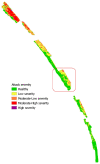Analysis of Dieback in a Coastal Pinewood in Campania, Southern Italy, through High-Resolution Remote Sensing
- PMID: 38256736
- PMCID: PMC10818449
- DOI: 10.3390/plants13020182
Analysis of Dieback in a Coastal Pinewood in Campania, Southern Italy, through High-Resolution Remote Sensing
Abstract
For some years, the stone pine (Pinus pinea L.) forests of the Domitian coast in Campania, Southern Italy, have been at risk of conservation due to biological adversities. Among these, the pine tortoise scale Toumeyella parvicornis (Cockerell) has assumed a primary role since its spread in Campania began. Observation of pine forests using remote sensing techniques was useful for acquiring information on the health state of the vegetation. In this way, it was possible to monitor the functioning of the forest ecosystem and identify the existence of critical states. To study the variation in spectral behavior and identify conditions of plant stress due to the action of pests, the analysis of the multispectral data of the Copernicus Sentinel-2 satellite, acquired over seven years between 2016 and 2022, was conducted on the Domitian pine forest. This method was used to plot the values of individual pixels over time by processing spectral indices using Geographic Information System (GIS) tools. The use of vegetation indices has made it possible to highlight the degradation suffered by the vegetation due to infestation by T. parvicornis. The results showed the utility of monitoring the state of the vegetation through high-resolution remote sensing to protect and preserve the pine forest ecosystem peculiar to the Domitian coast.
Keywords: GIS; Pinus pinea; Toumeyella parvicornis; remote sensing.
Conflict of interest statement
The authors declare no conflict of interest.
Figures








References
-
- Calandrelli M.M., Calandrelli R. The district tourism lake of Castel Volturno: An example of territorial requalification of abandoned quarries. In: Lollino G., Manconi A., Guzzetti F., Culshaw M., Bobrowsky P.T., Luino F., editors. Engineering Geology for Society and Territory: Urban Geology, Sustainable Planning and Landscape Exploitation. Volume 5. Springer; Cham, Switzerland: 2015. pp. 1315–1319.
-
- Rispo M., Calandrelli R., Calandrelli M.M. L’uso delle tecnologie digitali per il monitoraggio forestale: La pineta del litorale domitio [The use of digital technologies for forest monitoring: The pine forest of the Domitian coast]; Proceedings of the 10th National Congress of the Italian Society of Sylviculture and Forest Ecology; Florence, Italy. 15–18 September 2015; p. 101. (In Italian)
-
- Calandrelli M.M., Migliozzi A. Storia di degrado e di rinascita di una pineta costiera [History of degradation and rebirth of a coastal pine forest] Forest. 2023;20:73–80. doi: 10.3832/efor4386-020. - DOI
-
- D’Amico G., Francini S., Parisi F., Vangi E., De Santis E., Travaglini D., Chirici G. Multitemporal optical remote sensing to support forest health condition assessment of Mediterranean pine forests in Italy. In: Benítez-Andrades J.A., García-Llamas P., Taboada Á., Estévez-Mauriz L., Baelo R., editors. Proceedings of the Global Challenges for a Sustainable Society: EURECA-PRO 2022. Springer; Cham, Switzerland: 2023. Springer Proceedings in Earth and Environmental Sciences Series.
-
- Del Perugia B., Travaglini D., Bottalico F., Nocentini S., Rossi P., Salbitano F., Sanesi G. Le pinete litoranee di pino domestico (Pinus pinea L.) sono un paesaggio costiero in via di estinzione? Un caso di studio in Regione Toscana. Ital. For. E Mont. 2017;72:83–101. (In Italian)
LinkOut - more resources
Full Text Sources

